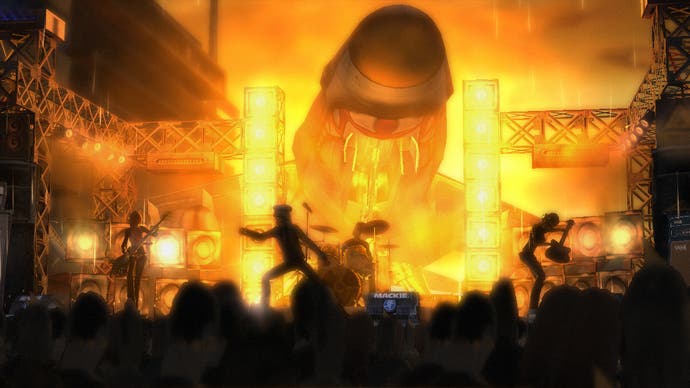Guitar Hero: World Tour
Rocking all over the lounge. Again.
Thanks to Guitar Hero: World Tour, we had to listen to Michael Jackson's Beat It blare out across the Leipzig business centre approximately 149 times per day for the entirety of Games Convention, interspersed occasionally with a brief rendition of Livin' On A Prayer. The former, at least, actually turns out to be quite decent typing music, so thanks for that, Activision!
There's something quite surreal about the speed with which Guitar Hero has captured the world. Three years ago, it was a curiosity import published by a peripheral manufacturer best known for its dance-mats. We distinctly remember the man in the godforsaken, middle-of-nowhere import shop where we first laid our eager hands on Guitar Hero advising us to hang on to it, assuming it'd be a valuable curiosity one day. Now it's a massive, global event, played on-stage by celebrities and in living rooms by, well, pretty much everyone on every console, and making an awful lot of money for everyone involved with it.
It's currently undergoing another metamorphosis, turning itself from a beat-matching videogame into a set of music tools, attempting to similarly morph its players into creators. We got the chance to see how exactly it's going about this in Germany, where Neversoft and Activision fully unveiled the new equipment and music creation software that we glimpsed earlier this year.
The finished peripherals really are things of beauty. It seems bizarre that we've managed to become connoisseurs in the field of pretend instruments at some point over the past five years or so, but the quality of the drum kit and new guitar would be obvious even to people who haven't spent inordinate amounts of time familiarising themselves with the old ones.

The drum kit, especially, is a definite step forward, and does far more than just raise two of the pads and make them roughly cymbal-shaped; it's sturdy, amazingly quiet, and has satisfying bounce to it, making drum rolls and improvisation easier - especially important for freestyling in music creation.
The guitar, too, has been designed with music-creation in mind. Small differences make the thing more pleasurable to play - a contoured strum-bar, funky-looking, dial-shaped start and select buttons, a Rock Band-style effects selector, a lovely (detachable) sunburst finish - but the major difference is a touch-sensitive panel near the bottom of the neck. It's used for soloing, tapping, and even strumming if you'd rather tap the neck than flick the strum-bar, but more excitingly, it's a second input in the music-creation suite, allowing you to modify what you're playing and enabling the guitar to be used as an all-purpose, flexible input device rather than just a five-button toy instrument.
The way that music-creation works is rather difficult to explain in words, but as soon as you get the chance to have a go, it all becomes clear. You start off in a jam session, where up to four players can choose an instrument - rhythm guitar, lead guitar, bass, synth or drums. You can then all play happily along in E Major on the default settings and make a surprisingly decent noise, or dive into the menus and start messing around with every conceivable aspect of the sound.

The first thing you can do is choose a scale, which naturally changes the notes that you can play with the guitar's five buttons and their various combinations. You can pick from any scale, or create your own if you're trying to play something complex. Guitar Hero: World Tour is partnered with Line6 amps, so you can pick from about sixty predefined guitar noises or twiddle a screenful of virtual knobs to create your own. You can instantly save any sound that you create, and with the touch of a button, everybody will be playing on the same scale, so one keen person can be the sound engineer for the entire band.
Playing the instruments is perfectly intuitive. The drums act just as you'd expect them to, and you find yourself with a surprisingly instinctive control over the sound whilst playing guitar. Tilting the guitars up and down changes the octave, giving you adequate note variation to play most things you'd want to without constantly having to switch scales. You can start recording at the touch of a button, and of course all the instruments record on separate tracks, so if the drummer skips a beat it can be re-recorded later.
This is all stuff that you'd probably expect from World Tour's music-creation tools, but the drum and synth machines go far further than we expected from the game. If you don't happen to know an excellent drummer, or if you're looking for a different sound from that of a drum-kit, you can use the guitar to control an unexpectedly sophisticated backing-track machine. It makes our plastic guitars into actual synthesisers.



